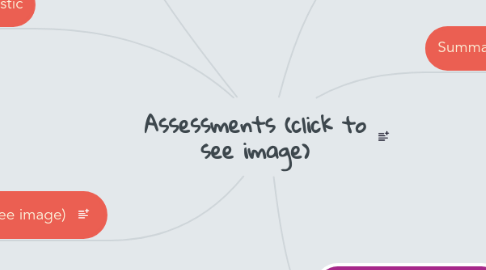Assessments (click to see image)
por Emily Cisneros


1. Interim/Benchmark
1.1. Definition: These are assessments that are given at pre-determined points of time. They are used to adjust instruction more formally, but do not give feedbak to students.
1.1.1. Report cards
1.1.2. District Reports
2. Diagnostic
2.1. Definition: Diagnostic assessments occur at the beginning of a course or unit. They are used to identify gaps in student learning so the instructor is aware of what the students know and do no know about the upcoming information.
2.1.1. Pre-Assessments
2.1.2. KWL Charts
3. Performance (Click to see image)
3.1. Definition: This type of assessment involves students performing a designated task. Instead of selecting from multiple choice, students demonstrate knowledge through completing a project.
3.1.1. Book Report
3.1.2. Designing Experiments
4. Formative (click to see image!)
4.1. Definition: These assessments help to form instruction. They collect evidence of student learning and provide teachers with feedback about what students are and are not understanding throughout the learning process.
4.1.1. Quizzes
4.1.2. Discussion
5. Summative
5.1. Definition: Summative Assessments occur at the end of learning a chunk of content. They are used to observe how much students retain.
5.1.1. Standardized tests
5.1.2. 6 Weeks Assessments
6. H.O.T Questions Force
6.1. Opening Questions
6.1.1. 1. Recall- What is force? (click for picture)
6.1.2. 2. What are the types of force you know?
6.2. Guiding Questions
6.2.1. 1. Explain the parts of this experiment. (click to view image)
6.2.2. 2. Analyze what would happen to an experiment if we had two variables instead of one.
6.3. Closing Questions
6.3.1. 1. Create an experiment in which one could test to answer the following question: how does mass affect the amount of force needed to pull and object.
6.3.2. 2. Judge- What could you do to improve the following experiment? (Click to view image)

